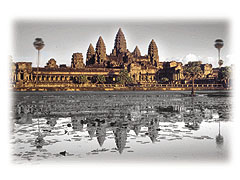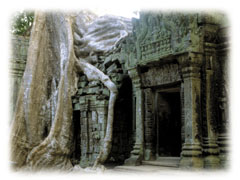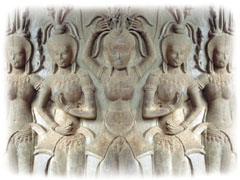Home
About Us
Booking Info
Travel forms
Custom Programs
FAQ
Country info
Volunteer
Client Comments
Weather
Insurance
Global Community
Service Foundation
Itinerary search
Order a Catalog!
Register Now

Or call:
1.800.419.4446
Email us
|
 |
Angkor, the ancient capital of the powerful Khmer Empire from the 9th-12th century, is home to one of the world’s archaeological gems and remains the spiritual and cultural center of Cambodia. The Angkor Archaeological Park consists of 70 ruins in an area of 77 square miles and is home to some of the most important structures, statues and carvings produced in the name of Buddhist and Hindu religions. Only rediscovered by French archeologists in the 19th century, many of the temples in the mystical “lost city in the jungle” have had to be reclaimed from the lush tropical vegetation. There are over 400 structures in total built between the 9th and 13th centuries and scattered over a large area. Some of the best-known temples are: Angkor Wat – the “city” which became a pagoda and the grandest and most sublime of all the Khmer temples;
|
Angkor Thom – with its magnificent southgate, and its towers of four faces pointing at each of the cardinal directions and elephants, preceded by the avenue of gods and asuras lining the bridge across the moat; Bayon – one of the most enigmatic and powerful religious constructions in the world and extremely complex both in terms of its meaning and structure – a mass of face-towers create a stone mountain of ascending peaks; Ta Prohm – a temple monastery embraced by trees, intertwined among the ruins created the special atmosphere of Ta Prohm; Banteay Srei – the remarkable small temple beauty, is routinely described as the “Jewel of Khmer Art.” It is located about 12 miles north of Angkor and almost at the foot of Kulen Mountains; Kabal Spean – with its amazing river of 1000 lingas (pillars representing the essence of the god);
|
 |
 |
Phnom Penh City, the capital of Cambodia is a bustling city nestled at the meeting point of three mighty rivers: the Mekong, the Tonle Sap and the Bassac. Once considered one of the most beautiful cities of the Orient, Phnom Penh still retains much of its original charm with the exotic roof lines of Khmer temples contrasting with old colonial architecture, the highlight of which is the Royal Palace, dominating the city with its grandeur and glowing golden colors. In addition, many of the buildings in Phnom Penh bear testimony to the strong French colonial influence evident in a number of classical French villas and wide tree-lined boulevards.
Siem Reap, without a doubt the major draw for visitors to Cambodia is Angkor, the ancient capital of the Khmer Empire, considered to be one of the ancient Wonders of the World. The town of Siem Reap at the northern edge of the great Tonle Sap Lake is the gateway to Angkor and the base for visiting the temple sites.
|
Sihanoukville, located 144 miles southwest of Phnom Penh (3-4 hour drive) is Kompong Som, (Sihanoukville), Cambodia’s only maritime port. A beach resort with sandy beaches, blue skies and a cool sea breeze, Sihanoukville has increasingly become a popular beach holiday destination. Local fisherman on charter boats will take visitors to nearby islands where the coral reefs, teeming with iridescent fish, are perfect for snorkeling, diving and fishing.
Tonle Sap, the Great Lake of Cambodia, is the largest body of fresh water in Southeast Asia and many fishermen make their living on the lake. A boat trip on the lake is the best way to appreciate its tranquil beauty.
|

|
|
|







